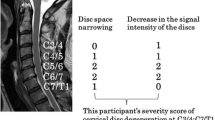Abstract
The aim of our study was to assess the blood concentrations of some trace elements and melatonin (MLT) in patients with intervertebral disc herniation (IDH) and to investigate the interaction of histological and biochemical degeneration findings with aging. The present study was carried out on 13 subjects (8 women and 5 men) diagnosed with IDH. They were divided into three groups according to their ages. Nighttime serum MLT, zinc (Zn), and magnesium (Mg) levels were determined in all patients. In addition, computed tomography (CT) scan of the brain and magnetic resonance imaging examination of the lumbar spine were obtained in this study. The Zn level and Zn/Mg ratio showed a decline in patients with IDH with aging, whereas the serum Mg level and tissue hydroxyproline content increased. A positive correlation between serum Zn and MLT concentrations was found (r=0.104, p=0.734). In addition, there was a positive correlation between serum Zn level and Zn/Mg ratio (r=0.835 and p<0.01), and a negative correlation between serum Mg level and Zn/Mg ratio (r=−0.571, p<0.05). On CT study, both volume percentage of calcified pineal gland and density of calcification were found to increase progressively with advancing age. The results of semiquantitative evaluation of disc tissues of patients with IDH for histological degeneration findings showed that 66.7% of discs treated had slight degeneration in younger age group, but 75.0% and 100% of discs had moderate or marked degeneration in older age groups. Our data indicated that there is a close relationship between MLT and Zn or Mg levels in the serum samples of patients with IDH, and the levels of these elements might be affected by the presence of degeneration process and serum MLT level, or vice versa.
Similar content being viewed by others
References
M. C. Battie, T. Videman, L. E. Gibbons, L. D. Fisher, H. Manninen, and K. Gill, 1995 Volvo Award in clinical sciences. Determinants of lumbar disc degeneration: a study relating to lifetime exposures and MRI findings in identical twins, Spine 20, 2601–2612 (1995).
J. A. Buckwalter, Spine update: aging and degeneration of the human intervertebral disc, Spine 20, 1307–1314 (1995).
A. G. Nerlich, E. D. Schleicher, and N. Boos, 1997 Volvo Award winner in basic science studies. Immunohistologic markers for age-related changes of human lumbar intervertebral discs, Spine 22, 2781–2795 (1997).
H. Paajanen, M. Erkintalo, R. Parkkola, J. Salminen, and M. Korman, Age-dependent correlation of low-back pain and lumbar disc regeneration, Arch. Orthop. Trauma Surg. 116, 106–107 (1997).
A. Vernon-Roberts, Disc pathology and disease states, in The Biology of the Intervertebral Disc, P. Ghosh P, ed., CRC, Boca Raton, FL, pp. 73–119 (1988).
E. J. Underwood, Trace Elements in Human and Animal Nutrition, 4th ed., Academic, New York (1977).
G. Cikim, H. Canatan, M. F. Gursu, F. Gulcu, G. Baydas, and A. E. Kilicoglu, Levels of zinc and lipid peroxiadation in acute coronary syndrome, Biol. Trace Element Res. 96, 61–68 (2003).
S. Michelle, P. Alain, and B. Françoise, Minerals, trace elements and related biological variables in athletes and during physical activity, Clin. Chim. Acta 321, 1–11 (2001).
G. Öztürk, Ş. Coşkun, D. Erbaş, and E. Hasanoglu, Effect of melatonin treatment on serum and tissue zinc levels in rats, J. Trace Elements Exp. Med. 15, 1–8 (2002).
C. Wallwork, Zinc and central nervous system, Prog. Food. Nutr. Sci. 11, 203–247 (1987).
S. Yazar, E. Kiliç, and R. Saraymen, Changes of total content of magnesium and zinc status in patients with chronic toxoplasmosis, Biol. Trace Elements Res. 92, 11–16 (2003).
R. J. Reiter, Pharmacological actions of melatonin in oxygen radical pathophysiology, Life Sci. 60, 2255–2271 (1997).
E. Mocchegiani, L. Santarelli, A. Tibaldi, et al., Presence of links between zinc and melatonin during the circadian cycle in old mice: effects on thymic endocrine activity and on the survival, J. Neuroimmunol. 86, 111–122 (1998).
G. K. Reddy and C. S. Enwemeka, A simplified method for the analysis of hydroxy-proline in biological tissues, Clin. Biochem. 29, 225–229 (1996).
J. J. Salminen, M. O. Erkintalo, J. Pentti, A. Oksanen, and M. J. Kormano, Recurrent low back pain and early disc degeneration in the young, Spine 24, 1316–1321 (1999).
J.-Y. Lee, R.-I. Ernestus, R. Schröder, and N. Klug, Histological study of lumbar intervertebral disc herniation in adolescents, Acta Neurochir. (Wien) 142, 1107–1110 (2000).
H. Kawamura, A. Ito, S. Miyakawa, et al., Stimulatory effect of zinc-releasing calcium phosphate implant on bone formation in rabbit femora, J. Biomed. Mater. Res. 50, 184–190 (2000).
P. P. N. Lee and S. F. Pang, Identification and characterization of melatonin binding sites in the gastrointestinal tract of duct, Life Sci. 50, 117–125 (1992).
M. T. Martin, F. Azpiroz, and J. R. Malagelada, Melatonin and the gastrointestinal tract, Therapie 53, 453–458 (1998).
S. C. Cunnane, D. F. Horrobin, M. S. Manku, and M. Oka, Alteration of tissue zinc distribution and biochemical analysis of serum following pinealectomy in the rat, Endocr. Res. Commun. 6, 311–319 (1979).
J. Limson, T. Nyokong, and S. Daya, The interaction of melatonin and its precursors with aluminium, cadmium, copper, iron, lead, and zinc: An adsorptive voltammetric study, J. Pineal Res. 24, 15–21 (1998).
P. Delagrange and B. Guardila-Lemaitre, Melatonin, its receptor, and relationship with biological rhythm disorders, Clin. Neuropharmacol. 20, 482–510 (1997).
O. Akyol, F. Ersan, F. Akcay, et al., Hair, nail, serum, and urine copper levels in users of copper intrauterine devices and interactions between copper and some other trace elements, Trace Elements Electrol. 14, 124–129 (1997).
F. Armutcu, E. Ozerol, A. Gurel, et al., Effect of long-term therapy with sodium valproate on nail and serum trace element status in epileptic children, Biol. Trace Element Res. 102, 1–10 (2004).
Author information
Authors and Affiliations
Rights and permissions
About this article
Cite this article
Turgut, M., Yenisey, Ç., Akyüz, O. et al. Correlation of serum trace elements and melatonin levels to radiological, biochemical, and histological assessment of degeneration in patients with intervertebral disc herniation. Biol Trace Elem Res 109, 123–134 (2006). https://doi.org/10.1385/BTER:109:2:123
Received:
Accepted:
Issue Date:
DOI: https://doi.org/10.1385/BTER:109:2:123




